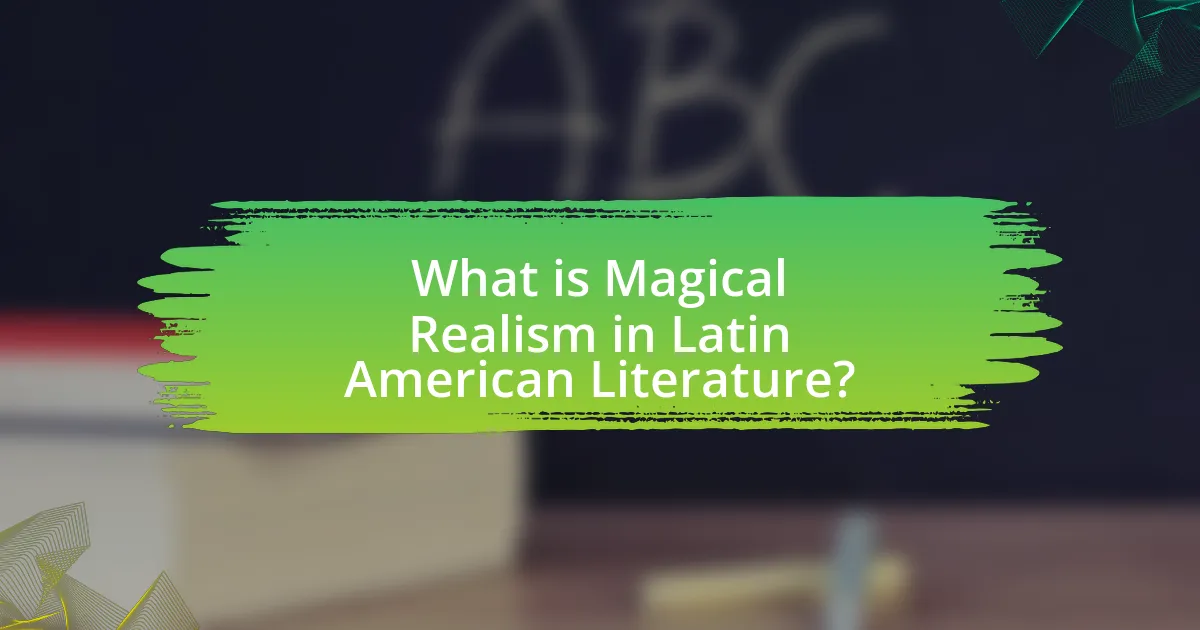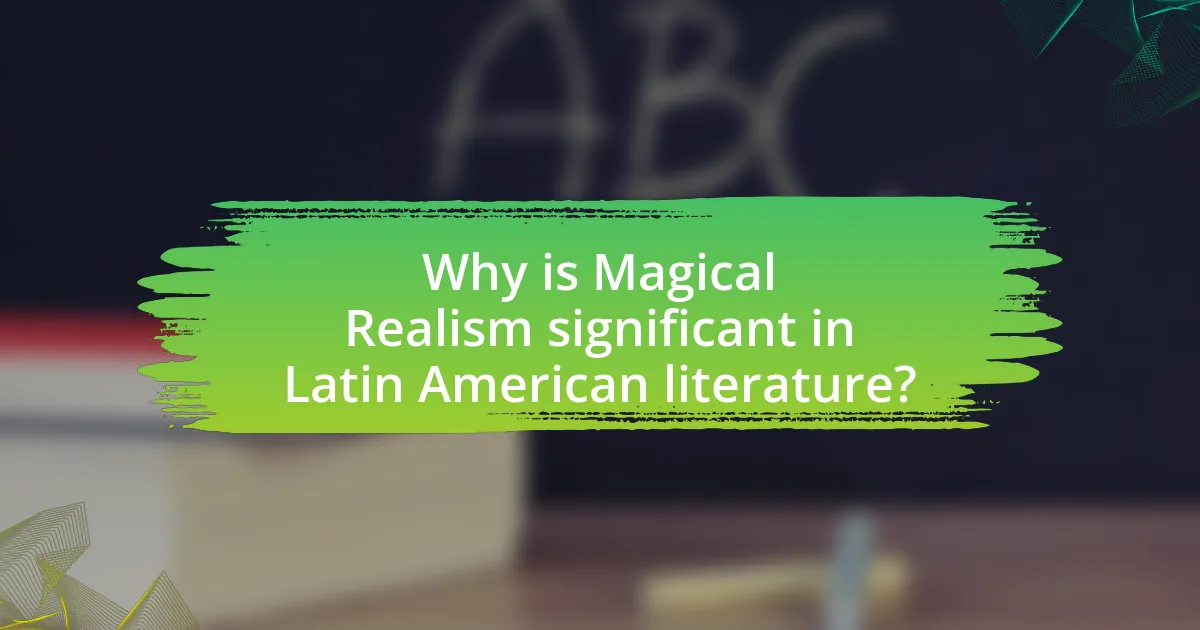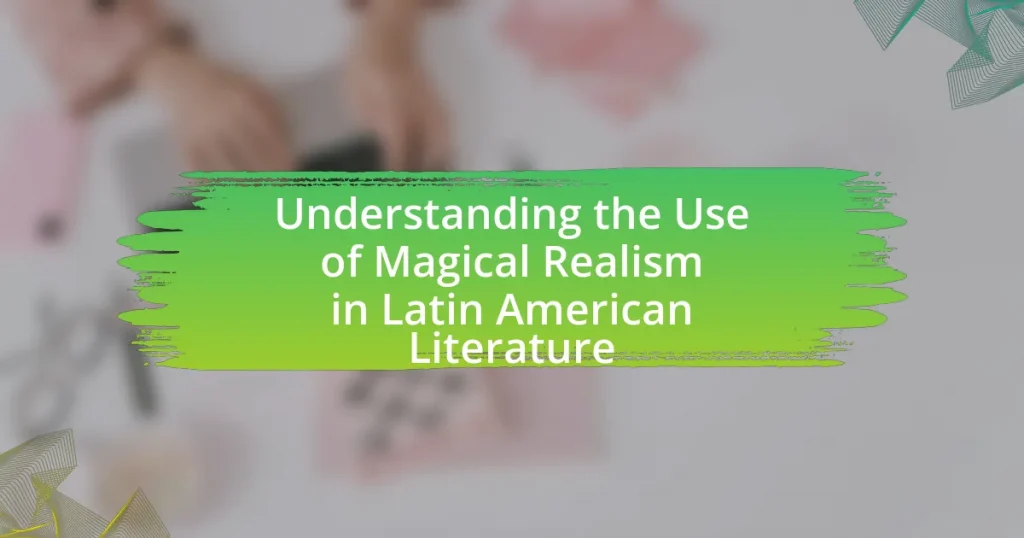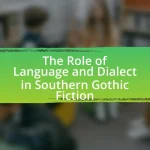Magical realism is a significant narrative style in Latin American literature that merges magical elements with realistic settings, allowing authors to depict extraordinary occurrences as part of everyday life. This genre emerged in response to the region’s complex social, political, and cultural realities, with key authors such as Gabriel García Márquez and Isabel Allende shaping its development. The article explores the historical and cultural factors contributing to magical realism, its defining characteristics, and the themes commonly addressed, such as identity and social issues. Additionally, it examines the genre’s global influence and offers insights into how readers can engage with and appreciate the themes presented in notable works.

What is Magical Realism in Latin American Literature?
Magical realism in Latin American literature is a narrative style that blends magical elements with realistic settings and events. This genre allows authors to present extraordinary occurrences as part of everyday life, creating a unique perspective on reality. Notable examples include Gabriel García Márquez’s “One Hundred Years of Solitude,” where the supernatural is seamlessly integrated into the mundane, reflecting cultural and historical contexts of Latin America. This approach often serves to explore complex themes such as identity, power, and social issues, making magical realism a significant literary movement in the region.
How did Magical Realism emerge in Latin American literature?
Magical Realism emerged in Latin American literature as a response to the region’s complex social, political, and cultural realities, blending fantastical elements with everyday life. This literary movement gained prominence in the mid-20th century, particularly through the works of authors like Gabriel García Márquez and Jorge Luis Borges, who incorporated local myths, folklore, and historical events into their narratives. The genre reflects the influence of indigenous cultures, colonial history, and the search for identity, allowing writers to explore themes of magic, reality, and the human experience in a uniquely Latin American context. The publication of García Márquez’s “One Hundred Years of Solitude” in 1967 is often cited as a pivotal moment that brought international attention to Magical Realism, solidifying its place in world literature.
What historical and cultural factors contributed to its development?
Magical realism in Latin American literature developed due to a combination of historical and cultural factors, including colonial history, political turmoil, and indigenous traditions. The colonial legacy established a blend of European and indigenous narratives, creating a unique storytelling style. Political instability, particularly in the 20th century, influenced writers to incorporate fantastical elements as a means of critiquing reality and expressing social issues. Additionally, the rich tapestry of indigenous myths and folklore provided a foundation for magical realism, allowing authors to weave the extraordinary into everyday life. This interplay of history and culture has solidified magical realism as a defining characteristic of Latin American literature.
Who are the key authors associated with the genre?
Key authors associated with the genre of magical realism in Latin American literature include Gabriel García Márquez, Isabel Allende, and Jorge Luis Borges. Gabriel García Márquez is renowned for his seminal work “One Hundred Years of Solitude,” which exemplifies the genre’s blending of magical elements with realistic settings. Isabel Allende’s “The House of the Spirits” also showcases magical realism through its incorporation of supernatural occurrences within a historical context. Jorge Luis Borges, while often associated with philosophical fiction, has significantly influenced magical realism with his intricate narratives that blur the lines between reality and fantasy. These authors have shaped the genre, making it a defining characteristic of Latin American literature.
What are the defining characteristics of Magical Realism?
Magical Realism is characterized by the seamless integration of magical elements into a realistic setting, creating a narrative where the extraordinary is treated as ordinary. This genre often features a strong sense of place, typically rooted in Latin American culture, and employs rich, descriptive language that enhances the surreal aspects of the story. Additionally, it frequently explores themes of identity, history, and social issues, reflecting the complexities of life in Latin America. Notable authors such as Gabriel García Márquez and Isabel Allende exemplify these characteristics in their works, blending the magical with the mundane to challenge readers’ perceptions of reality.
How does Magical Realism blend the ordinary with the extraordinary?
Magical Realism blends the ordinary with the extraordinary by incorporating fantastical elements into realistic settings, creating a narrative where magical occurrences are accepted as part of everyday life. This genre often features characters who experience extraordinary events without questioning their reality, which reflects cultural beliefs and social issues prevalent in Latin American societies. For instance, Gabriel García Márquez’s “One Hundred Years of Solitude” illustrates this blend through the Buendía family’s experiences, where magical events coexist with mundane realities, emphasizing the interconnectedness of the two realms. This technique allows authors to explore deeper truths about human experience, identity, and history, making the extraordinary feel familiar and relatable.
What role does the supernatural play in these narratives?
The supernatural serves as a crucial element in narratives of magical realism, often blurring the lines between reality and fantasy. This blending allows authors to explore complex social, political, and cultural issues within Latin American contexts, using supernatural occurrences to reflect the characters’ inner lives and societal struggles. For instance, in Gabriel García Márquez’s “One Hundred Years of Solitude,” the presence of magical elements illustrates the cyclical nature of history and the impact of colonialism, demonstrating how the supernatural can provide deeper insights into human experiences and societal dynamics.

Why is Magical Realism significant in Latin American literature?
Magical Realism is significant in Latin American literature because it uniquely blends magical elements with realistic settings, reflecting the region’s complex social, political, and cultural realities. This literary style allows authors to explore themes such as identity, power, and the supernatural, often serving as a critique of societal norms and historical events. Notable works, such as Gabriel García Márquez’s “One Hundred Years of Solitude,” illustrate how magical realism can convey deeper truths about human experience and the Latin American condition, making it a vital narrative form in the region’s literary canon.
How does Magical Realism reflect social and political realities?
Magical realism reflects social and political realities by intertwining fantastical elements with everyday life, thereby highlighting the complexities of cultural identity and historical context. This literary style often emerges in Latin American literature as a response to colonialism, dictatorship, and social injustice, allowing authors to critique societal norms and political structures. For instance, Gabriel García Márquez’s “One Hundred Years of Solitude” illustrates the cyclical nature of history and the impact of political turmoil on personal lives, showcasing how magical elements serve to emphasize the absurdities of reality. Additionally, the blending of the magical with the mundane allows for a deeper exploration of marginalized voices and experiences, making the invisible visible and challenging dominant narratives.
What themes are commonly explored through Magical Realism?
Common themes explored through Magical Realism include the intersection of reality and fantasy, cultural identity, social and political issues, and the nature of time. These themes allow authors to reflect on the complexities of Latin American life, where the magical often coexists with the mundane. For instance, Gabriel García Márquez’s “One Hundred Years of Solitude” illustrates the cyclical nature of history and the impact of solitude on personal and collective identity, showcasing how magical elements serve to deepen the exploration of these themes.
How do authors use Magical Realism to critique society?
Authors use Magical Realism to critique society by blending fantastical elements with realistic settings, thereby highlighting social injustices and cultural issues. This literary technique allows authors to address complex themes such as oppression, identity, and power dynamics in a way that resonates with readers on both emotional and intellectual levels. For instance, Gabriel García Márquez’s “One Hundred Years of Solitude” illustrates the cyclical nature of violence and corruption in Latin American history, using magical elements to emphasize the absurdity of these societal issues. Similarly, Isabel Allende’s “The House of the Spirits” employs supernatural occurrences to explore themes of gender inequality and class struggle, effectively critiquing the patriarchal structures within society. Through these narratives, authors utilize Magical Realism not only to reflect reality but also to provoke thought and inspire change regarding societal norms and injustices.
What impact has Magical Realism had on global literature?
Magical Realism has significantly influenced global literature by blending fantastical elements with realistic settings, thereby expanding narrative possibilities. This genre, prominently featured in Latin American literature through authors like Gabriel García Márquez and Isabel Allende, has encouraged writers worldwide to explore the intersection of the ordinary and the extraordinary. The global impact is evident in the adoption of Magical Realism techniques in diverse literary traditions, allowing for richer storytelling that reflects cultural complexities. For instance, Márquez’s “One Hundred Years of Solitude” not only garnered international acclaim but also inspired a wave of writers across continents to incorporate similar stylistic elements, demonstrating the genre’s transformative power in literature.
How has the genre influenced writers outside of Latin America?
Magical realism has significantly influenced writers outside of Latin America by encouraging them to blend fantastical elements with realistic settings, thereby expanding narrative possibilities. For instance, authors such as Salman Rushdie and Toni Morrison have incorporated magical realism techniques in their works, using surreal elements to explore complex themes of identity and culture. Rushdie’s “Midnight’s Children” exemplifies this influence, as it intertwines historical events with magical occurrences, reflecting the postcolonial experience. Similarly, Morrison’s “Song of Solomon” employs magical realism to delve into African American heritage and folklore, demonstrating the genre’s capacity to address cultural narratives beyond its Latin American origins.
What are some notable works that exemplify this influence?
Notable works that exemplify the influence of magical realism in Latin American literature include “One Hundred Years of Solitude” by Gabriel García Márquez, “The House of the Spirits” by Isabel Allende, and “The Kingdom of this World” by Alejo Carpentier. “One Hundred Years of Solitude” intricately weaves the fantastical with the historical, showcasing the Buendía family’s multi-generational saga in the fictional town of Macondo, which reflects the complexities of Latin American identity. “The House of the Spirits” combines personal and political narratives, blending the supernatural with the historical context of Chile. “The Kingdom of this World” explores the intersection of magic and history during the Haitian Revolution, illustrating how magical realism serves as a lens to understand cultural and social realities in Latin America. These works collectively highlight the genre’s ability to merge the extraordinary with the mundane, offering profound insights into the human experience.

How can readers better appreciate Magical Realism in Latin American literature?
Readers can better appreciate Magical Realism in Latin American literature by immersing themselves in the cultural and historical contexts that shape the narratives. Understanding the socio-political background of Latin America, particularly the impact of colonialism and dictatorship, enhances the comprehension of the blending of magical elements with everyday life. For instance, Gabriel García Márquez’s “One Hundred Years of Solitude” reflects the tumultuous history of Colombia, where the extraordinary becomes a lens to view reality. Engaging with the symbolism and themes prevalent in the genre, such as the cyclical nature of time and the exploration of identity, allows readers to grasp the deeper meanings behind the fantastical elements. Additionally, recognizing the influence of indigenous myths and folklore can enrich the reading experience, as these stories often serve as a foundation for the magical aspects in the literature.
What are some common misconceptions about Magical Realism?
Common misconceptions about Magical Realism include the belief that it is solely about fantasy or that it lacks a connection to reality. In fact, Magical Realism blends magical elements with realistic settings, emphasizing the coexistence of the extraordinary within the ordinary. This genre often reflects cultural and social realities, particularly in Latin American literature, where authors like Gabriel García Márquez and Isabel Allende use magical elements to address complex themes such as identity, politics, and history. Additionally, some people mistakenly think that Magical Realism is a genre exclusive to Latin America, while it has influenced writers globally, demonstrating its universal appeal and adaptability.
How can understanding cultural context enhance the reading experience?
Understanding cultural context enhances the reading experience by providing deeper insights into the themes, symbols, and characters within a text. In the realm of Latin American literature, particularly in magical realism, cultural context allows readers to grasp the significance of blending the magical with the ordinary, which reflects the region’s historical, social, and political complexities. For instance, Gabriel García Márquez’s “One Hundred Years of Solitude” illustrates how understanding the historical backdrop of Colombia, including its colonial past and civil strife, enriches the reader’s interpretation of the narrative’s magical elements as a commentary on reality. This contextual awareness fosters a more nuanced appreciation of the author’s intentions and the cultural nuances embedded in the storytelling.
What should readers look for when analyzing Magical Realism texts?
Readers should look for the interplay between the magical and the mundane when analyzing Magical Realism texts. This genre often blurs the lines between reality and fantasy, presenting extraordinary events as part of everyday life. Key elements to examine include the cultural and historical context that informs the narrative, as well as the characters’ responses to magical occurrences, which often reflect deeper social and political themes. For instance, Gabriel García Márquez’s “One Hundred Years of Solitude” illustrates how magical elements serve to highlight the cyclical nature of history and the complexities of Latin American identity. Analyzing these aspects can reveal how Magical Realism critiques societal norms and explores human experience.
What are some recommended readings to explore Magical Realism?
Some recommended readings to explore Magical Realism include “One Hundred Years of Solitude” by Gabriel García Márquez, “The House of the Spirits” by Isabel Allende, and “Chronicle of a Death Foretold” also by Gabriel García Márquez. These works exemplify the genre’s blending of magical elements with realistic settings and themes, showcasing the unique narrative style that defines Magical Realism. “One Hundred Years of Solitude” is often cited as a seminal text, illustrating the cyclical nature of history and the intertwining of the fantastical with everyday life, while “The House of the Spirits” explores personal and political histories through a magical lens. “Chronicle of a Death Foretold” employs a non-linear narrative to reveal the complexities of fate and societal norms, further solidifying the genre’s impact in Latin American literature.
Which classic and contemporary works should be on every reader’s list?
Classic and contemporary works that should be on every reader’s list include “One Hundred Years of Solitude” by Gabriel García Márquez and “The House of the Spirits” by Isabel Allende. These novels exemplify magical realism, a genre that blends fantastical elements with realistic settings, reflecting Latin American culture and history. “One Hundred Years of Solitude,” published in 1967, is a seminal work that explores themes of solitude and the cyclical nature of history, while “The House of the Spirits,” released in 1982, intertwines personal and political narratives, showcasing the impact of historical events on individual lives. Both works are essential for understanding the depth and richness of magical realism in Latin American literature.
How can readers engage with the themes presented in these works?
Readers can engage with the themes presented in works of magical realism by actively analyzing the interplay between the fantastical and the mundane. This engagement involves recognizing how authors like Gabriel García Márquez and Isabel Allende use magical elements to reflect cultural, social, and political realities in Latin America. For instance, in “One Hundred Years of Solitude,” Márquez illustrates the cyclical nature of history through magical occurrences, prompting readers to consider the implications of historical repetition in their own lives. By examining these connections, readers can deepen their understanding of the broader themes of identity, memory, and the human experience as depicted in magical realism.






